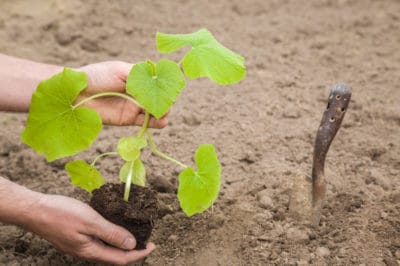When is the Best Planting Time for Pumpkins?
There is no set date to by which to have pumpkin seeds in the ground. Instead, you must judge when to plant by the last frost date in your growing zone. Pumpkin seeds need a consistent soil temperature of at least 65°F (18°C) to germinate, so if your days are warm but the nights are still freezing, you can be sure the ground is not ready for planting pumpkins.
Measuring Soil Temperature
Experienced gardeners may be able to accurately gauge when the soil has reached the optimal temperature for planting pumpkin seeds. However, to be 100% sure that you do not plant your seeds too early, using a soil thermometer is essential.
To measure the temperature of the soil where you are planting pumpkins, first use a screwdriver or a sturdy stick to poke a hole in the ground at the planting depth. For pumpkins, the standard depth is one inch (2.5 centimeters). Gently push the thermometer to the bottom of the hole and read the gauge. If it is 65° F (18°C), you can plant your pumpkin seeds.
Tip: You can also use a standard kitchen thermometer to measure the soil temperature.
Starting Pumpkin Seeds Indoors
If you are antsy to get started growing pumpkins, but the soil is not yet warm enough, one option is to start the seeds indoors about four weeks before the last frost date in your growing zone.
The easiest way to start pumpkin seeds indoors is to purchase peat pots or planting pellets. Fill the containers with good quality soil or rehydrate the pellets, plant your seeds, and place in a sunny location. The seeds should germinate within ten days.
After the pumpkin seeds have sprouted, water them regularly and expose them to as much sun as possible. After four weeks, they should have two sets of leaves and can be transplanted outdoors.
Tip: Pumpkin varieties with a growing season of 100-125 days should always be started indoors in colder climates.
Know Your Planting Zone
Whether you have started the pumpkin seeds in the ground or you are planting them directly into the ground, knowing your growing zone is essential. The United States Department of Agriculture (USDA) has created a map to show the correct planting times for your geographical area.
Tip: You can also get that information at most home and garden centers or by talking with an experienced gardener in your neighborhood.
Planting Pumpkins Directly Into the Ground
Once the soil has reached the correct temperature of 65°F (18°C), you can plant the pumpkin seeds directly into the earth. Whether you are planting in hills or rows, plant the seeds at a depth of 1 inch (2.5 centimeters).
If planting in rows, the space between them should be between 6-10 feet (1.8-3 meters). Hills should have 4-8 feet (1.2-2.4 meters) of space between them.
Tip: If space is an issue, try planting pumpkins in a container.
Caring For Pumpkin Plants
Regardless of the variety planted, all pumpkins need an abundance of the following:
- A minimum of six hours of direct sunlight.
- Frequent watering, enough to keep the soil damp.
- Fertilizer. Feed with an organic fertilizer every three weeks.
The Stages of Pumpkin Growth
The pumpkin seeds should germinate in approximately 7-10 days provided the soil is warm enough. Germination is evident when small green sprouts shoot up through the earth.
Through the next 4-6 weeks, the pumpkin sprouts will continue to grow, and the vines will start to spread across the ground.
Midway through the growing cycle, yellow pumpkin blossoms will bloom on the vines. The flowers are both male and female, and both are required to pollinate the plant and produce fruit.
After the blossoms fade, you will see fruits appear. In the last half of the growing season, the pumpkins will grow larger and turn from light green to dark green and finally, a vibrant orange.
Tip: All pumpkin fruits are some shade of green until toward the end of the season. The final color depends on the variety planted.
Knowing When to Harvest Pumpkins
Harvesting pumpkins is the reward for the entire season of work. In late September to early October, your garden will be full of color from the pumpkins.
Once the vines have started to die off, and the stems of the pumpkins have stiffened, you can safely harvest the fruits. If there are still spots of green on the shell, turn them over so the green is facing the sun and they will ripen.
Tip: If a hard frost is imminent, cover the plants or harvest all of the pumpkins including the green ones. Pumpkins are very sensitive to freezing temperatures.
Storing Pumpkins
After harvesting the pumpkin crop, you can safely store them for several months in a cool, dark place. Just wash the pumpkins with an antibacterial soap and place them on newspapers or cardboard.
Whether you use your pumpkins for carving Jack O’Lanterns, for decoration, or for feasting on, knowing when to plant pumpkins and how to take care of them is definitely worth the work you put into them.
